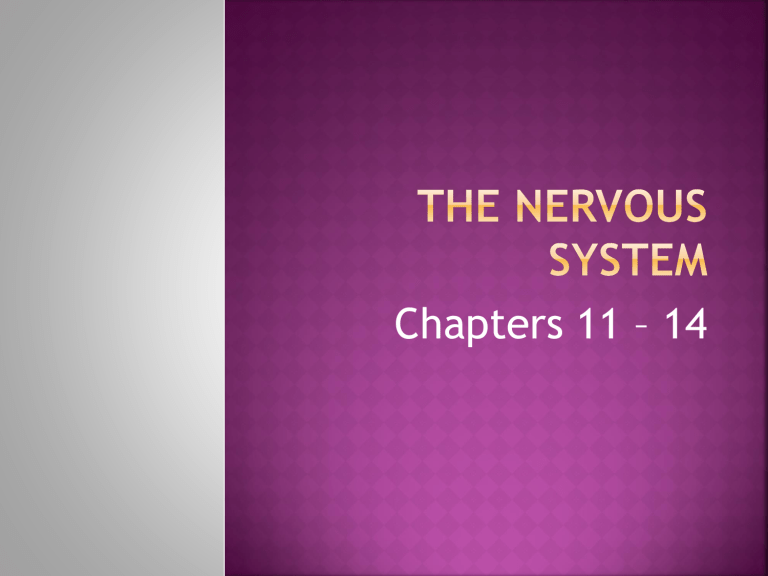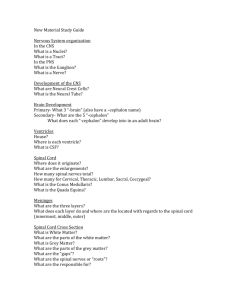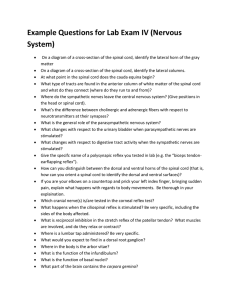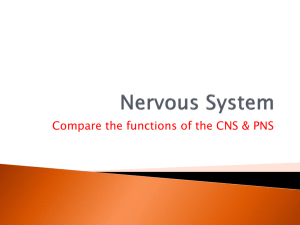Functions of the Nervous system

Chapters 11 – 14
Brain
Spinal cord
Nerves
Sensory receptors
Sensory input – sight, taste, touch, blood pH or blood pressure
Integration – sensory input can cause immediate response, be stored as memory, or be ignored
Homeostasis – internal balance
Mental activity – consciousness, thoughts
Control of muscles & glands
Central Nervous System (CNS)
Consists of the brain and spinal cord
Peripheral Nervous System (PNS)
External to CNS
Consists of sensory receptors, nerves, ganglia, and plexuses
12 pairs of cranial nerves (from brain)
31 pairs of spinal nerves (from spinal cord)
Afferent divison – Sensory
Transmits action potentials (APs) from sensory receptors to CNS
Efferent division – Motor
Transmits APs from CNS to the effector organs – muscles and glands
Subdivided into
Somatic Nervous System
Autonomic Nervous System (ANS)
Somatic transmits APs from the CNS to skeletal muscles
These muscles are voluntarily controlled through the somatic nervous sys.
Autonomic transmits APs from the CNS to smooth and cardiac muscles, and certain glands
Involuntarily controlled
2 subdivisions
Sympathetic division
Most active during physical activity
Parasympathetic division
Regulates resting or vegetative functions
Digesting food or emptying bladder
Enteric nervous system – consists of plexuses in wall of digestive tract – acts independently of CNS
Neurons – receive stimuli and conduct action potentials
Nonneural cells
Neuroglia / Glial cells: support and protect neurons and perform many other functions
Account for over ½ the brain’s weight
Can be 10-50x more neuroglial cells than neurons in certain parts of brain
Astrocytes – star-shaped with cytoplasmic processes that extend from cell body
Form a supporting framework for blood vessels and neurons
Assist in formation of blood-brain barrier
Figure 11.6, page 379
Ependymal – line the ventricles of brain and central canal of spinal cord
Choroid plexuses secrete cerebrospinal fluid
Move fluid through cavities of brain
Figure 11.7, page 379
Microglia – specialized macrophages in the CNS
Become mobile and phagocytic in response to inflammation
Phagocytize necrotic (dead/dying) tissue, microorganisms, and foreign substances that invade CNS
Figure 11.8, page 379
Oligodendrocytes – have cytoplasmic extensions that can surround axons
If extensions wrap many times, they form the myelin sheaths.
Single cell can form myelin sheaths around portions of several axons
Figure 11.9, p. 380
Schwann cells - neurolemmocytes
Neuroglial cells in the PNS that wrap around axons, many times around will form a myelin sheath
Can only form around a portion of one axon
Satellite cells – surround neuron cell bodies in ganglia
Provide support, and can provide nutrients to the neuron cell bodies
Figure 11.10 – 11.11, page 380
Myelinated Axons - Fig 11.12a
Extensions from oligodendrocytes or
Schwann cells wrap around segments of an axon to form a phospholipid-rich membranes, these areas are called
“internodes”
Nodes of Ranvier – interruptions in the myelin sheath
White Matter
Unmyelinated Axons – Fig 11.12b
These axons rest in invaginations of the oligodendrocytes & Schwann cells
The cell membranes surround each axon, but do not wrap around it many times like a myelin sheathed axon
Each axon can be surrounded by a series of cells
Each cell can surround more than one unmyelinated axon
Gray Matter
Spinal cord - the major comm. link between the brain and all parts of the
PNS inferior to the head
Integrates incoming info and produces responses through reflex mechanisms
Extends from the foramen magnum to the level of the 2 nd lumbar vertebrae
Has cervical, thoracic, lumbar, and sacral segments
Segments named for where nerves enter & exit
31 pairs that exit vertebral column through intervertebral and sacral foramina – Fig 12.1, p. 412
Nerves in lower segments have to descend further down vertebral canal b/c cord is shorter than vert. Column
Spinal cord is not uniform in diameter
Larger at superior end & gradually ↓
Cervical enlargement
Lumbosacral enlargement
Meninges: connective tissue membranes that surround the brain & spinal cord (Figure 12.2, p. 413)
Consist of three layers
Dura Mater – most superficial, thickest layer
Forms the thecal sac that surrounds spinal cord
Arachnoid Mater – thin, wispy layer that looks like cobwebs
Pia Mater – deepest layer, bound very tightly to spinal cord
Reflex Arc: the basic functional unit of the nervous system
The smallest, simplest portion capable of receiving a stimulus and producing a response
5 basic components (Fig 12.5, p. 416)
A sensory receptor
A sensory neuron
An interneuron
A motor neuron
An effector organ
Reflex: an automatic response to a stimulus produced by a reflex arc.
Stretch Reflex: simplest in which muscles contract in response to a stretching force applied to them
Example: Patellar (knee-jerk) reflex
Golgi Tendon Reflex: prevents contracting muscles from applying excessive tension to tendons
Withdrawal (Flexor) Reflex: removes a limb or other body part away from a painful stimulus
Reciprocal Innervation – flexor - extensor
Crossed Extensor Reflex – retract - extend
Consist of axons, Schwann cells, and connective tissue – Fig 12.12, p. 421
Each nerve fiber and its Schwann cell sheath is surrounded by delicate layer known as endoneurium
The perineurium surrounds groups of axons to form to form nerve fasicles
3 rd layer is the epineurium which binds the nerve fascilces together to form a nerve – the conn. tissue is continuous with dura mater surrounding the CNS.
Cervical, Thoracic, Lumbar, and Sacral nerves have specific locations & functions – Fig 12.13a, 12.13b – p. 422
Named by a letter (associated with which region it is in) and a # which tells us the location of the nerve within each region.
C 1- C8
T 1- T12
L 1- L5
S1 – S5
Co 1
Figure 12-14, Dermatomal Map, p. 423
Brain – consists of the brainstem, cerebellum, diencephalon, and the cerebrum (table 13.1, p. 444)
Brainstem – consists of the medulla oblongata, pons, midbrain, and reticular formation
12 pairs of cranial nerves that belong to the PNS
Organized
Like math & reading
Logical
Don’t enjoy clowning around
Skilled at sequencing ideas
Like verbal lectures over textbooks
Needs quiet to study
LEFT
Good at art
Creative
Prefers working in groups
Dreamers
Can memorize music
Good at geometry
Prefers to summarize vs outline
RIGHT
I.
II.
III.
IV.
V.
VI.
Olfactory
Optic
Oculomotor
Trochlear
Trigeminal
Abducent
VII.
Facial
VIII.
Vestibulocochlear
IX.
X.
XI.
XII.
Glossopharyngeal
Vagus
Accessory
Hypoglossal
The following reflexes in the brainstem involve the cranial nerves:
Turning your eyes to a flash of light, sudden noise, or touch on the skin
Moving your eyes to track a moving object
Keep your teeth from biting too hard on hard objects
Move tongue out of way to keep from biting it while chewing food








